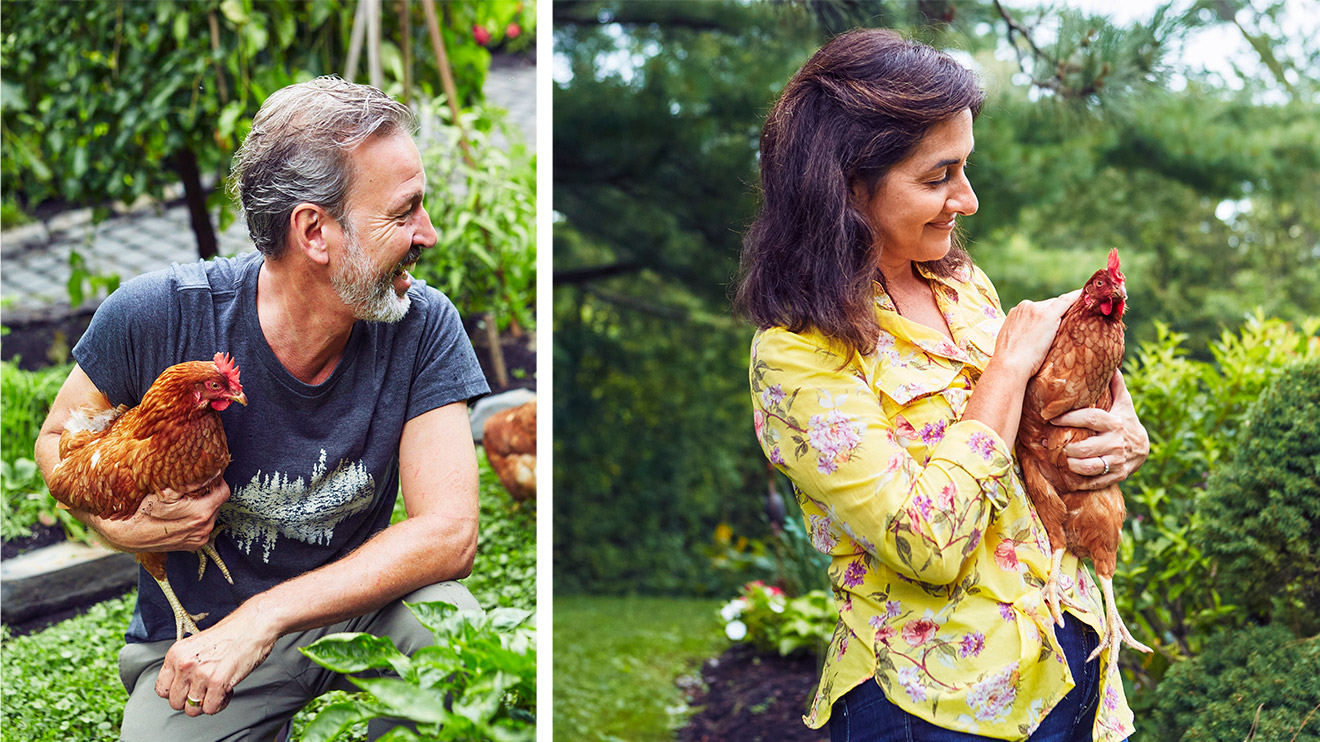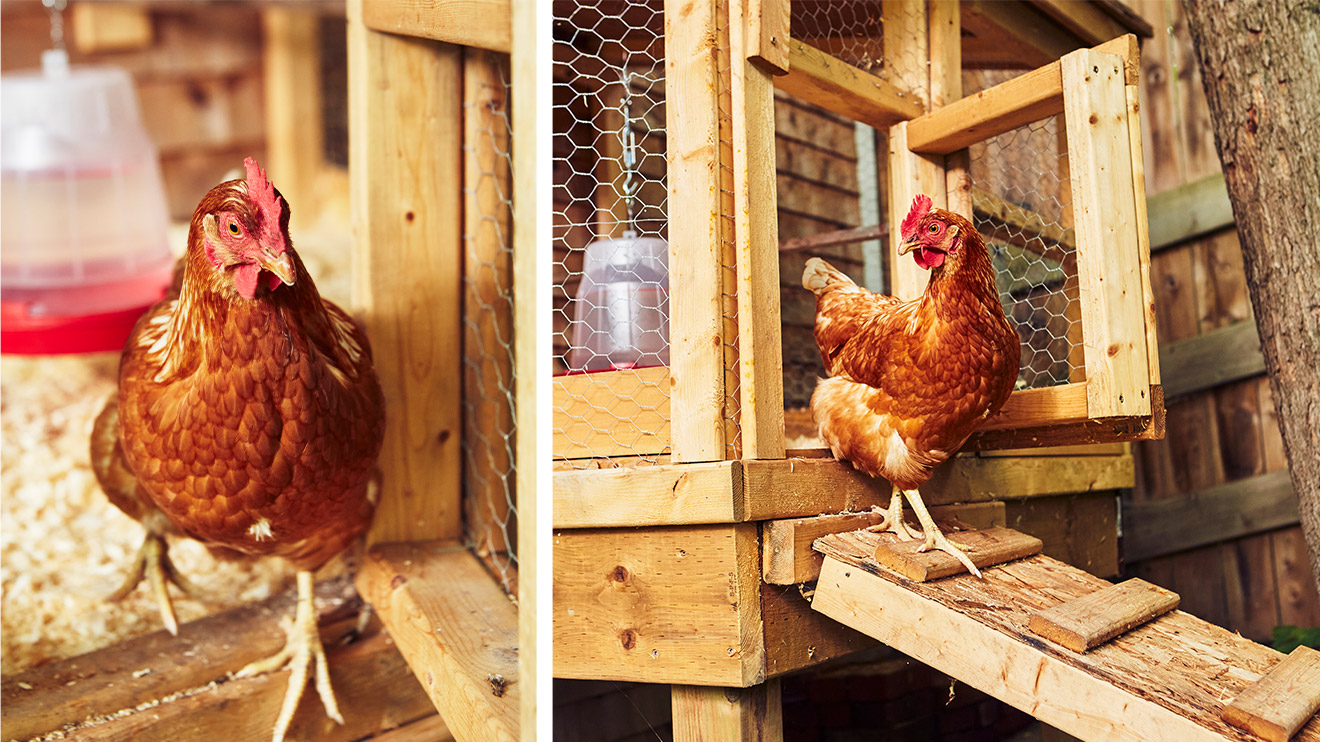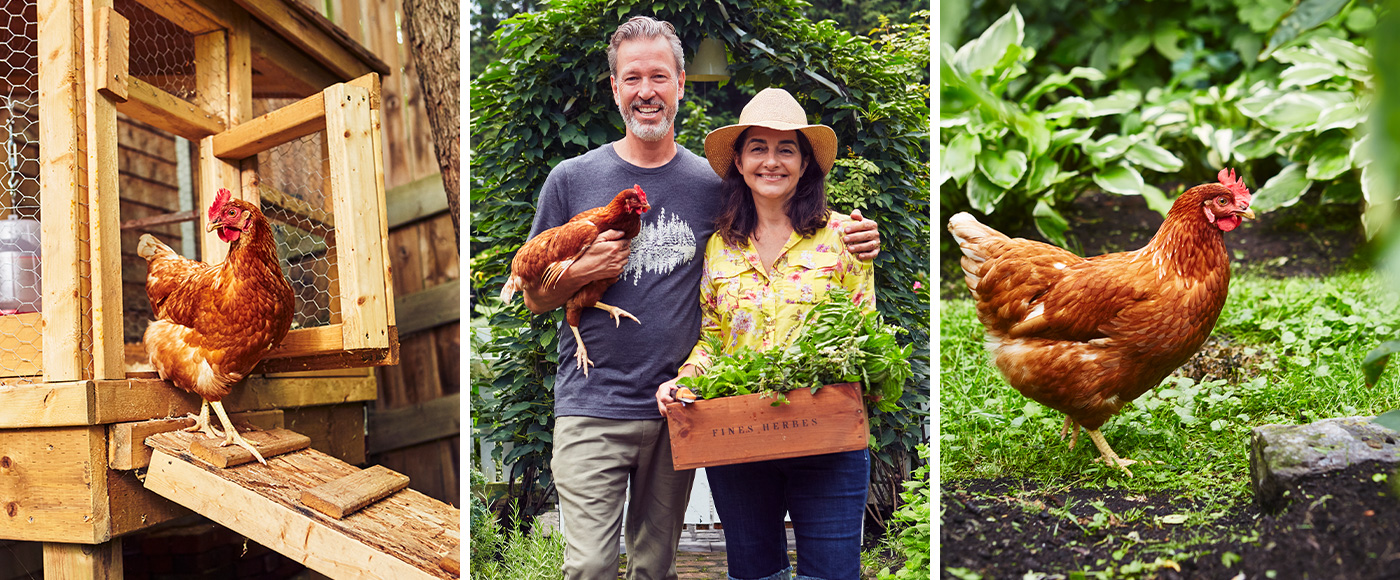
“I always had chickens when I was little. My mother would arrive with 10 chicks at Easter when we lived in Saint-Michel! My first chicken coop was at the HQ in Saint-Lambert, on the roof of the RICARDO store. My second is the one I did at my home in Chambly—the first city in Quebec to allow chickens—last summer in my shed.”
Chickens
What I like about chickens is their curiosity. They are affectionate and will follow you if you spend time with them. The trick to get a hen to listen is to call them with the same sound that you would use when giving them food! I’ve had many varieties of hens, from the most traditional to the most exceptional. The most common is the redhead, and that’s the one that Brigitte and I have adopted at home.
Good to know:
- You should ideally choose a vaccinated hen; the price varies, around $25 per hen.
- It is not recommended to integrate new hens into your chicken coop right away.
- Warning: They can quickly become endearing and entertaining!

The chicken coop
I built my chicken coop in my shed, which was already insulated. So they have a hut in the shed and their enclosure is outside. If you want a safe coop, know that you’ll need a fence at least 5 to 6 feet high because hens fly! Also, they like to have a place where there is earth and sand to wash in. Sand breaks the eggs of parasites, which is essential. In winter, I put diatomaceous earth below the wood chips in the chicken coop.
“Almost everyone in Quebec has a shed that can be used as a base for an urban chicken coop! Plus, they’re often in the back of the yard, near trees, where there is shade and where electricity is often already installed. It’s the cheapest and most accessible option.”
Good to know:
- Check with your municipality to make sure you’re allowed to have a chicken coop at home and be familiar with the regulations around it.
- The chicken coop should be large enough to properly accommodate the number of hens you will have. Look it up!
- It must contain nesting boxes so that the hens can lay their eggs in comfort. Some organic chicken coops will even put small curtains for more privacy! Ricardo uses milk crates with wood chips.
- The coop must contain a perch since the hens sleep perched. It must not be round and must be well sanded. Hens also like to have a perch in their outdoor space for warm summer evenings.
- A sandbox with diatomaceous earth must be made available to them to wash in—it’s their bath!
- Their water must be fresh and be at the height of their back.
- Their food should also be at the height of their back, ideally suspended.
- Wood chips are placed on the floor, which can then be composted when cleaning.
In my opinion, there are two main challenges in the urban hen adventure—but in both cases there are solutions!
- 1. Flies! In this case, there are fly traps and tape.
- 2. The smell! For this, it is very important to change the wood chips—it smells good afterwards! Once a week, I turn the earth in the enclosure and it yields a super rich soil. I then use this earth for all my flower beds.
What about winter?
Yes, it’s cold here in the winter...and it snows! But you can keep your chicken without problems by effectively insulating your chicken coop and providing it with enough daylight. In winter, I add a heat lamp with a timer as well as a thermometer to keep the temperature around 10 degrees Celsius. I move their drinker inside the chicken coop to prevent the water from freezing. Despite the colder temperature, chickens like to go out on beautiful days and choose to go back in whenever they want! The number one enemy of a hen is moisture, so in the summer I open the window of the shed and in the winter I close it.
Good to know:
- During the winter season, there may be a drop in egg-laying.
- It is very important to make sure that the water doesn’t freeze.
- Some varieties of hens do not tolerate the Quebec winter (redheads have no problem).
Care and nutrition
The basic feed is in the form of pellets. But, unsurprisingly, a hen needs calcium to form its eggs (by the way, to find out if a hen is doing well, a good tip is to look at the eggs). I always buy a bag of oyster shells that I add to the feed. It is also possible to break them with a hammer but I am not quite there yet! I also give them hand-crushed egg shells that I mix with leftovers from the dinner table.
A hen loves grass! When I cut the grass, I always give them some. In the winter, I ask my grocer for containers of salad and spinach that are no longer good and I give it to my chickens since they don’t have access to grass. They also eat weeds and dinner leftovers. Mine love leftover spaghetti, couscous, slices of bread and lettuce leaves! I always have a plate for them in the fridge.
Good to know:
- Be aware that chickens are omnivores so they eat everything (or almost everything): grains, grass and meal leftovers in moderate quantities. You will find their feed in mills and agricultural stores.
- In terms of table scraps, here is what should not be given to hens: avocado, onion, potatoes, citrus fruits, tomatoes, eggplants, salted food, chocolate and beans. Be aware that, like humans, each hen has its food preferences and some are more difficult than others!
- And be careful, they also love what’s in your garden! Prevent them from eating your rhubarb leaves, as they are poisonous.
- Cleaning the chicken coop is very important. You need to remove the droppings under the perch—ideally daily—and do a good cleaning on the inside and outside of the coop every month.
- You can put the droppings in the compost and then use it in the garden a few months later by mixing it up regularly.
- At night, all traces of food should be removed if you have fed the hens outside during the day, to avoid attracting other animals.

Eggs
Normally, a hen lays about 1 egg per day. With 4 hens, you will therefore have more than 2 dozen eggs per week! Luckily, we have more than 160 recipes online highlighting them. For my part, I wash my eggs and keep them in the fridge so as not to take a chance, but know that they do not need to be stored in the refrigerator when they are not washed, because they have a protective layer.
We eat 80% of the eggs at breakfast. In the summer, I often cook omelettes at lunchtime with the leftovers. I also love making desserts like angel food cake, because the yolks are very colourful. My vanilla ice cream is super-yellow because of my chickens’ eggs; it’s amazing! Another surprising fact I learned along the way: When the chickens have just laid their eggs, it is impossible to cook a hardboiled egg!
Good to know:
- Eggs are considered extra fresh for 9 days after laying.
- The size of the eggs can vary but it’s around 40 grams for a standard red hen.
- It’s possible to have an 80-gram egg containing two yolks, as well as small 20-gram eggs containing no yolk. Nature is not uniform and that’s perfectly fine!

EGGS
All Our Recipes
What does Ricardo appreciate most about having a chicken coop at home? The affectionate presence of the hens, the obligation to go outside in the morning, and being part of a less wasteful and more ecological initiative. Plus, for families with children, it helps empower the little ones!
Since we have more expertise in recipes with eggs than in the breeding of hens to produce them, here are reliable resources to provide more detailed information if the adventure of having chickens at home interests you:

